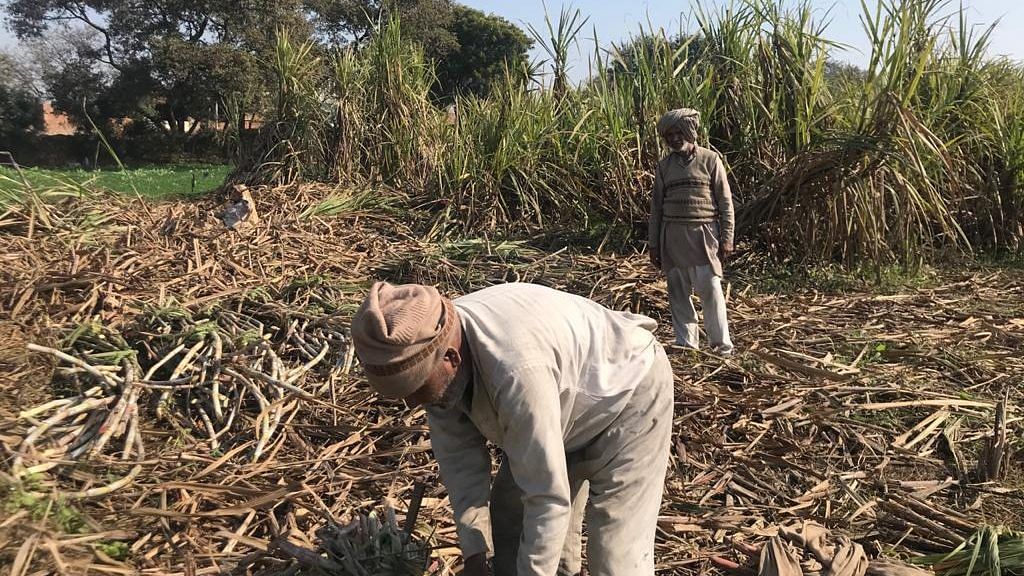New Delhi: Ahead of the assembly elections in Uttar Pradesh, Punjab and a number of other states, the Union Cabinet Wednesday approved an increase in the Fair and Remunerative Price (FRP) on sugarcane to Rs 290 a quintal, an increase of Rs 5 from the previous year.
According to the government, the decision will benefit 5 crore sugarcane farmers and their dependents, as well as five lakh workers employed in sugar mills and related ancillary activities.
The ruling BJP hopes the move will address resentment among sugarcane farmers, particularly in Western Uttar Pradesh.
A number of BJP leaders as well as those of the RSS-affiliated Bharatiya Kisan Sangh (BKS) had pointed out that there was resentment among farmers over the issue of static cane prices and delayed payment in Uttar Pradesh, something that could have a bearing on the elections.
Union Minister Sanjeev Balyan, who is a Jat leader from Muzaffarnagar in Western UP, had in the past been raising the issue of sugarcane prices and had urged the Yogi Adityanath government to resolve the issue.
The central government announces the FRP, the minimum price that sugar mills have to pay to cane growers, every year before the start of the sugarcane crushing season from October.
Many state governments, including Uttar Pradesh and Punjab, have also been announcing their own sugarcane rates, known as the state advised price or SAP, which is given to farmers in the state and is usually higher than the FRP.
For example, in UP for 2021-22 marketing year (October-September), the central government FRP was Rs 285/quintal while the state SAP for general variety stood at Rs 315/quintal. As a result, a farmer was receiving around Rs 315/quintal for sugarcane produce from sugar mills.
Despite the current up-gradation in sugarcane FRP by Rs 5 to Rs 290/quintal for 2021-22 marketing year, the farmers in UP will continue to receive Rs 315/quintal for their cane produce from mills since the state SAP has remained the same.
The increase in FRP of sugarcane by the central government is bound to benefit cane farmers across the country especially in major producing states Maharashtra, Uttar Pradesh, Karnataka and Tamil Nadu.
A majority of upcoming poll-bound states, however, have a sizeable presence of sugarcane cultivation in their region with many farmers cultivating this long-term crop. These include Uttar Pradesh, Punjab, Gujarat, and Uttarakhand, which come under the list of top ten states growing sugarcane.
Also read: Taliban takeover shakes up Indian dry fruit market, prices surge ahead of festive season
Sugarcane in UP
Sugarcane is a major source of income for farmers in Uttar Pradesh and the issue of delayed payments and the static state price had created a lot of anger among farmers, many of whom had also been protesting against the three farm laws passed by the Modi government.
Bharatiya Kisan Union (BKU) leader Rakesh Tikait, who has become the face of the farm protests in UP, had met Chief Minister Yogi Adityanath in November last year and had called for the SAP to be raised from Rs 325 to Rs 400.
The government, however, had in February decided to stick to the old rates. BJP leaders are hoping that the rise in FRP will assuage some of the anger.
“Tikait had cleverly linked the sugarcane price demand and the problems that were being faced by the farmers with the three farm laws of the government,” a senior BJP leader said. “He managed to get support from the farmer community especially in the Jat-dominated Western Uttar Pradesh. With an increase in the FRP that issue will definitely get buried.”
Some in the BJP, however, still feel that the Yogi government in Uttar Pradesh should increase the SAP too.
“Elections are around the corner and the opposition is trying to milk the issue. With the farm protests still going on, many sugarcane farmers have aligned with it too, which can have a bearing on our performance in Western UP,” a second BJP leader said. “Increasing the FRP is welcome but the state will also have to do something now that Punjab has already approved it for its farmers.”
The opposition has attempted to take advantage of the issue.
Attacking the BJP government, senior Congress leader Priyanka Gandhi Vadra took to Twitter Wednesday to point out that while her party government in Punjab increased sugarcane prices, the Yogi government has not done so.
“The Congress government of Punjab listened to the farmers and raised the price of sugarcane to Rs 360/quintal,” she tweeted. “The UP BJP government, which came with a promise of Rs 400/quintal for sugarcane, has not raised a single penny on the price of sugarcane for 3 years and threatens the farmers if they raise their voices.”
पंजाब की कांग्रेस सरकार ने किसानों की बात सुनी और गन्ने के दाम 360रू/क्विंटल किए।
गन्ने का 400रू/क्विंटल का वादा करके आई उप्र भाजपा सरकार ने 3 साल से गन्ने के दाम पर एक फूटी कौड़ी नहीं बढ़ाई है और किसानों द्वारा आवाज उठाने पर "देख लेने" जैसी धमकी देती है।
— Priyanka Gandhi Vadra (@priyankagandhi) August 25, 2021
Giving in to the demands being raised by the farmers in Punjab, Chief Minister Amariner Tuesday approved a SAP of Rs 360/quintal from the earlier Rs 310/quintal.
Sugarcane FRP
The FRP is fixed following recommendations from various stakeholders, but primarily from the Commission of Agricultural Costs and Prices (CACP), a statutory body that advises the government on pricing policy such as MSP for major farm produce.
According to a government statement Wednesday, the cost of production of sugarcane for the 2021-22 season is Rs 155/quintal. Therefore, an FRP of Rs 290/quintal will provide farmers with a more than 50 per cent return on production costs.
Union Minister Piyush Goyal also maintained that the price of sugar would not increase due to an increase in the FRP.
(Edited by Arun Prashanth)
Also read: Why you may not shed tears over onion prices this year
